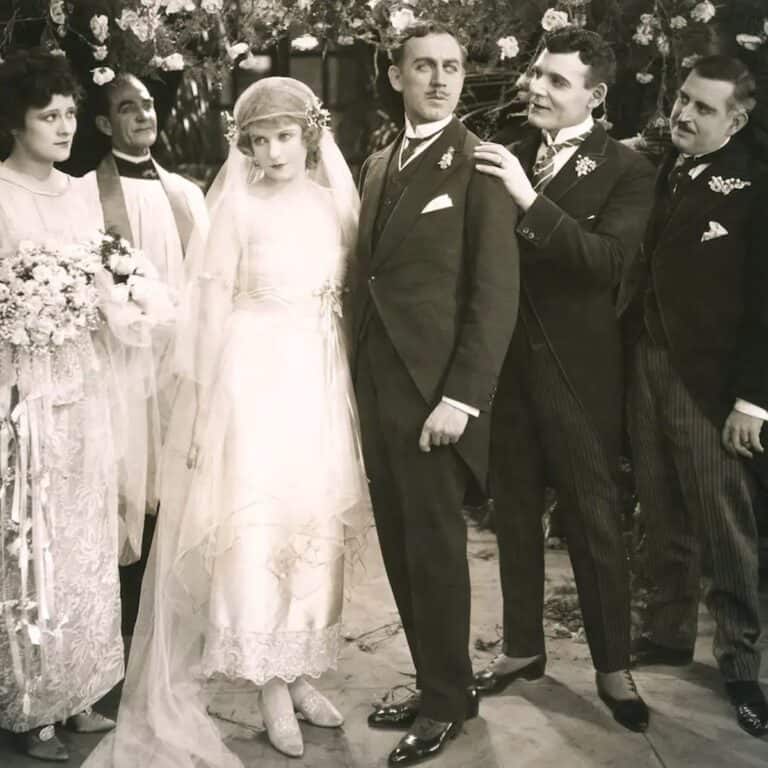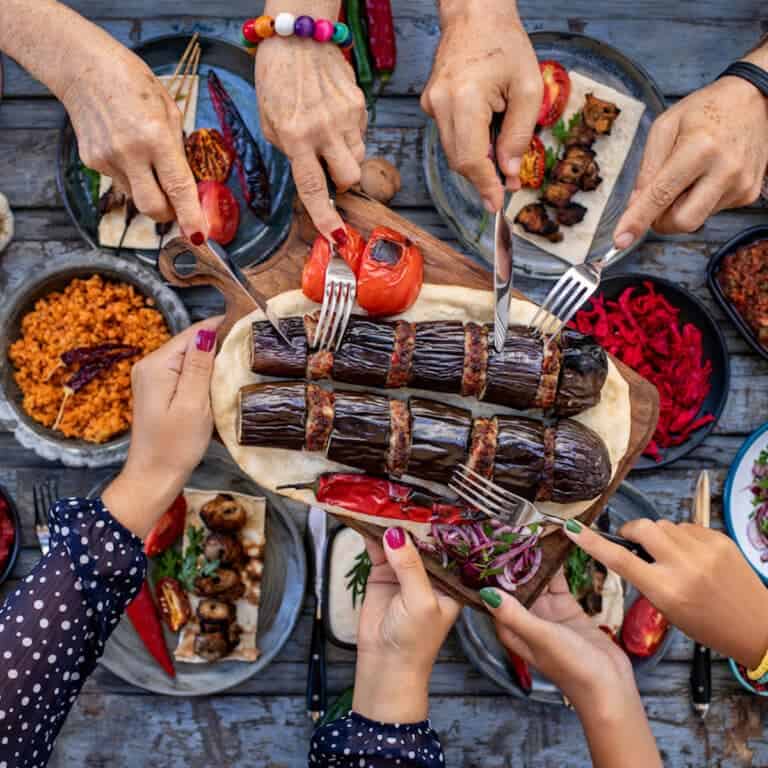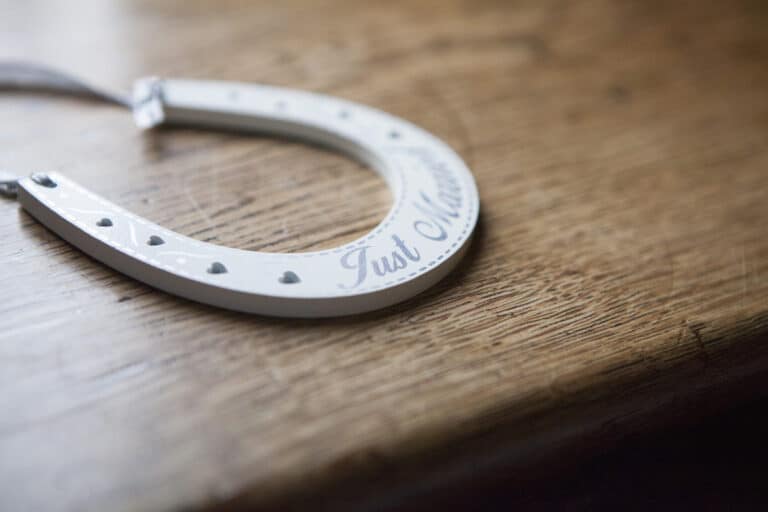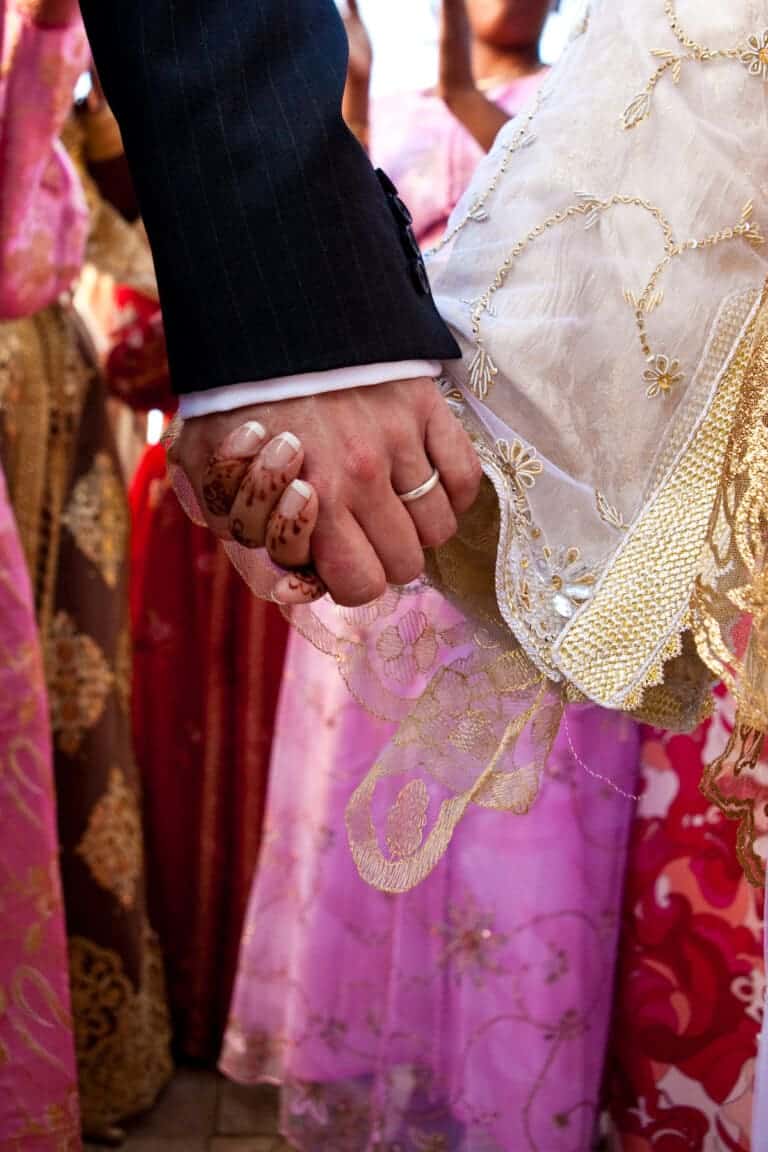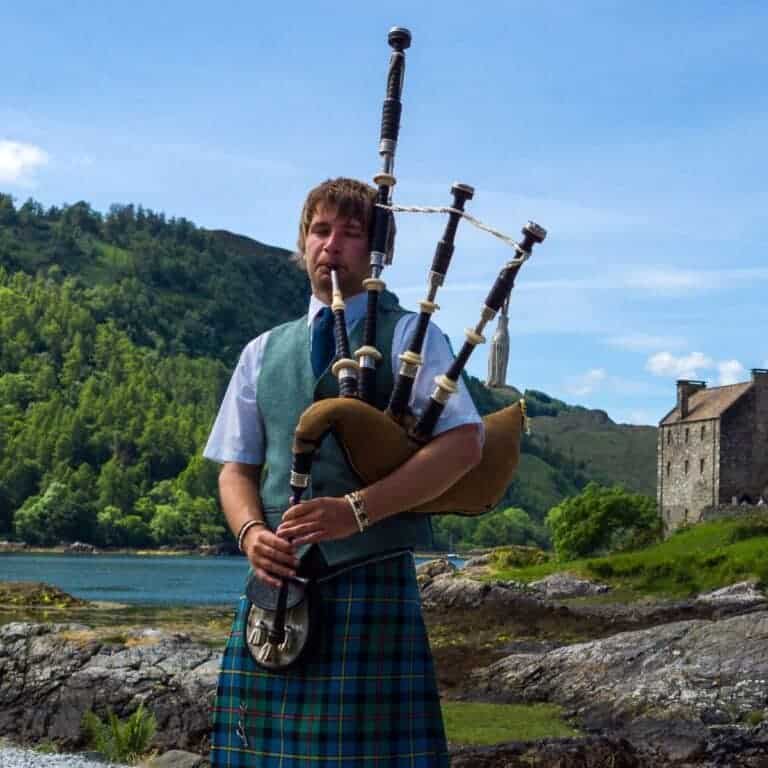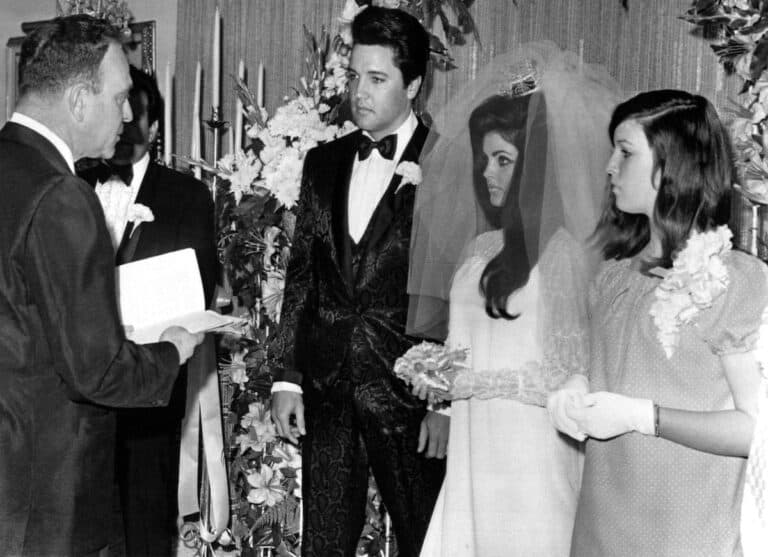Everything You Need To Know About Handfasting Ceremonies
You may have already heard about the ancient tradition of handfasting. In recent years, handfasting has experienced a resurgence in popularity. Many couples of diverse backgrounds are choosing to incorporate this meaningful tradition into their wedding day. A handfasting ceremony is a beautiful way to symbolize the union of two lives. Combining ancient Celtic tradition with modern expressions of love and commitment.
In this article, we explore the history and origins of handfasting. We cover who can perform and participate in the ceremony. Along with the ceremony process, the different types of handfasting knots and when the ceremony takes place during a wedding. We also touch upon the legal status of handfasting and other unity rituals that can be included in a wedding.

What is handfasting?
Handfasting is a term used to describe an ancient Celtic and Pagan tradition that involves tying a couple’s hands together during their marriage ceremony. The act of handfasting symbolizes the couple’s union and commitment to each other.
This tradition is thought to date back to the pre-Christian era. However, in recent years, many modern couples include this symbolic gesture from ancient times in their weddings or civil unions as a symbol of the couple’s commitment.
What is the process of a handfasting ceremony?
The handfasting process starts before the ceremony. The couple selects a cord, ribbon, or piece of fabric for handfasting. The material often holds personal significance or is chosen based on color symbolism. Some couples opt for handfasting cords with multiple strands, each representing a different aspect of their relationship or desired qualities in their marriage. The number of cords used will depend on the number of people in the unity ceremony.
The officiant or chosen person performing the ceremony may begin by blessing the handfasting cord and expressing positive intentions for the couple’s future together.
As the couple holds hands, the officiant will drape the cord over the couple’s hands, creating a figure-eight or infinity symbol. As the vows are spoken, the officiant will wrap the cord around the couple’s hands, symbolically binding them together. The wrapping can be done loosely, allowing for easy removal afterward or tighter, requiring the couple to work together to untie the knot carefully.
Once the couple’s hands are bound together, the officiant may offer a final blessing for the couple’s future. This is followed by the pronouncement of the couple as married, united, or committed to one another, depending on the nature of the ceremony. The couple is then presented to the gathered friends and family as a newly united pair.
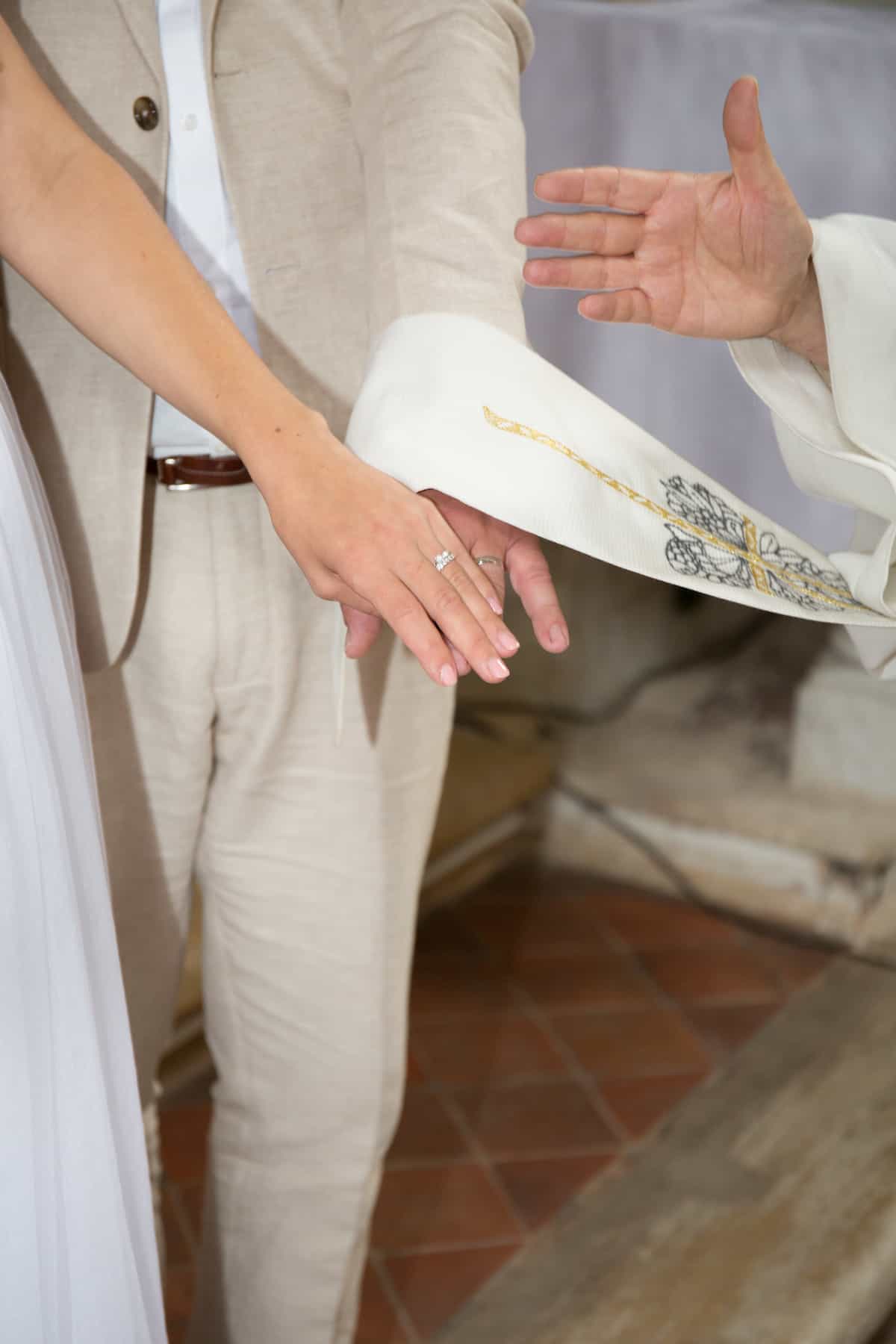
The history behind handfasting
The word “handfasting” comes from the Old English word “handfæsting,” which means “the act of making a contract by joining hands.” This act of binding the hands of the couple together has a special significance beyond just the physical act of tying a knot.
The ritual of handfasting dates back to the pre-Christian era as part of pagan ceremonies in Scotland, Ireland, and other parts of the Celtic world. This ancient wedding ritual was often practiced in rural areas and was a way for couples to declare themselves married.
In some regions, such as ancient Ireland, the handfasting custom was a public declaration of intent. A couple would bind their hands, usually in the presence of a priest, and declare themselves engaged. This engagement would last around a year. This ritual would declare the woman spoken for unless the couple chose not to get married after the year-long engagement.
During these ceremonies, the couple’s hands were tied with handfasting cords to symbolize their union and commitment. The handfasting cords were made from natural materials like ribbons or braided cord. These cords were often decorated with flowers, beads, or other meaningful symbols to the couple.
Where the traditions began
The tradition of handfasting continued through the Middle Ages when the Catholic Church attempted to suppress pagan customs and beliefs. Despite these efforts, handfasting remained a popular tradition among Celtic people and was often performed secretly.
The handfasting ritual is special for those of Celtic heritage. Many feel it is a way to connect with their ancestral roots and cultural traditions.
Who performs a handfasting ceremony?
Handfasting ceremonies are a custom that transcends religious boundaries. Understanding who can perform a handfasting ceremony is essential to ensure a memorable and authentic experience for you as a couple. Although a handfasting practitioner commonly performs this ceremony, a wedding celebrant or even family members or friends can perform the ceremony.
Historically, handfasting ceremonies were conducted by Druids, Celtic priests, or Pagan High Priestesses. Today, couples can still choose to have a handfasting ceremony led by a modern-day Druid or Pagan officiant, especially if they wish to honor the tradition’s origins. Many couples choose to have their wedding officiant perform the ceremony. This can be a minister, rabbi, imam, or religious leader. Couples can work closely with their chosen officiant to incorporate the handfasting ritual into their wedding ceremony in a way that aligns with their beliefs and values.
For couples who prefer a non-religious ceremony, celebrants such as Humanist officiants, interfaith ministers, or a justice of the peace can perform a handfasting ceremony. These officiants often work with the couple to create a unique and personalized ceremony. One that reflects their love story, values, and aspirations for their future together.
Sometimes, couples may have a close friend or family member perform the handfasting ceremony. This can add a personal touch and deep emotional connection to the ritual. However, it’s a good idea that your chosen individual is comfortable with public speaking and clearly understands the handfasting process.
Who can be handfasted?
Handfasting has evolved over time to become an option for couples from various cultural and religious backgrounds. Due to its pagan and Celtic roots, handfasting is still widely practiced by modern-day Pagans, Wiccans, and other followers of Earth-based spirituality. It is also an excellent choice for couples from different religious or cultural backgrounds. It can be easily adapted to respect and honor both traditions.
Handfasting is an inclusive ritual that welcomes couples of all gender identities and sexual orientations. Same-sex couples may incorporate a handfasting ceremony into their wedding or civil union to meaningfully and personally celebrate their love and commitment meaningfully and personally.
Some couples celebrating a significant milestone in their relationship, such as an anniversary, may include a handfasting ceremony as part of their vow renewal. This can be a poignant way to reaffirm your love and commitment to one another.
Handfasting is also a beautiful way to unite a family. Whether you are including your own children or bringing together your children of previous marriages. A wedding handfasting ceremony is a lovely way to incorporate blended or extended family into your big day and unite you all as one big family.
When does the handfasting ceremony take place?
There are no strict rules regarding the timing of a handfasting ceremony. The handfasting ritual can take place at various points during a wedding. This will depend on the couple’s preferences and the structure of the overall ceremony.
Some couples choose to perform the handfasting ceremony before reciting their vows. You may choose to integrate it into your vow exchange. As the vows are read, the couple’s hands will be bound together as they recite their wedding vows.
Some couples prefer to perform the handfasting ceremony after exchanging their vows and rings. This can serve as an additional symbol of their commitment, and a separate set of handfasting vows may be included. This is a good choice if you are including other family members in the unity ritual.
It is possible for the handfasting ceremony to be the main event. Including this ceremony in a vow renewal or having a dedicated handfasting wedding ceremony to declare your commitment to one another allows you to base the whole event around this ritual. It is up to each individual couple to decide what is right for them.

Is handfasting legally binding?
In 18th century England, handfasting was a legally binding marriage between men and women. However, a legal marriage today requires a marriage license, meaning this type of ceremony is no longer considered legally binding.
How long should handfasting cords be?
1-2 meters is a good length, allowing the cords to be wrapped around both hands of the couple. You may wish to include other family members, such as children or grandchildren, in the ceremony. In this case, add another cord or ribbon to incorporate them into this symbolic unity ritual.
What are the different types of handfasting knots?
Several types of knots can be used, each with unique symbolism and aesthetic appeal. Here are some popular handfasting knot options:
- Infinity Knot: The Infinity Knot, also known as the Figure-Eight Knot. A simple yet powerful symbol of eternal love and commitment. This knot is created by looping the handfasting cord around the couple’s hands. Forming the shape of a figure-eight or an infinity symbol. This knot represents the never-ending nature of the couple’s love, and their lives intertwine.
- The Gift Knot: The Gift Handfasting Knot represents the couple’s love, commitment, and the intertwining of their lives. As the knot forms a heart shape, it visually embodies the affection and devotion shared between the couple. Additionally, its interlocking loops signify the strong bond between the partners and the balance and harmony in their relationship.
- Draping Knot: The draping technique symbolizes the couple’s commitment and union. The couple is visually and symbolically bound together by draping the cord or ribbon over their hands. Representing their intention to support and care for one another throughout their lives.
- Side by Side Knot: The “side by side” concept highlights the equal partnership between the couple, representing their shared commitment to love, support, and care for one another. A side-by-side positioning allows couples to face their guests and creates fantastic handfasting photo opportunities.
- Celtic Knot: The Celtic Knot, also known as the Lovers’ Knot or Josephine Knot. This intricate and visually stunning knot represents the interconnectedness of the couple’s lives. The knot features a continuous loop that weaves around itself, with no real beginning or end.
Other unity rituals to include in your wedding
There are many wonderful unity ceremony ideas to make your day extra special. Here are a few ideas you could incorpatrate into your ceremony:
- Unity Candle: The couple lights a single candle together, representing the joining of their two lives into one.
- Sand Ceremony: The couple pours two separate containers of sand into a single vase, symbolizing the blending of their lives.
- Wine Ceremony: The couple drinks from a single cup of wine, symbolizing their shared future and the sharing of life’s joys and sorrows.
- Tree Planting: The couple plants a tree together, symbolizing the growth of their love and the strength of their bond over time.

Final thoughts
Handfasting is a profoundly symbolic and personalized way for couples to express their love and commitment to one another. Couples can honor their heritage by incorporating this ancient tradition into their wedding ceremonies and establishing a solid foundation for their life together. Whether you choose a traditional Celtic knot or a contemporary draping technique, the handfasting ceremony is a beautiful way to celebrate the love you share with your partner.
For more wedding traditions information, check out these posts:

